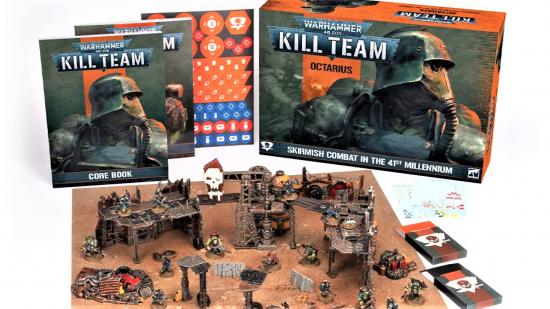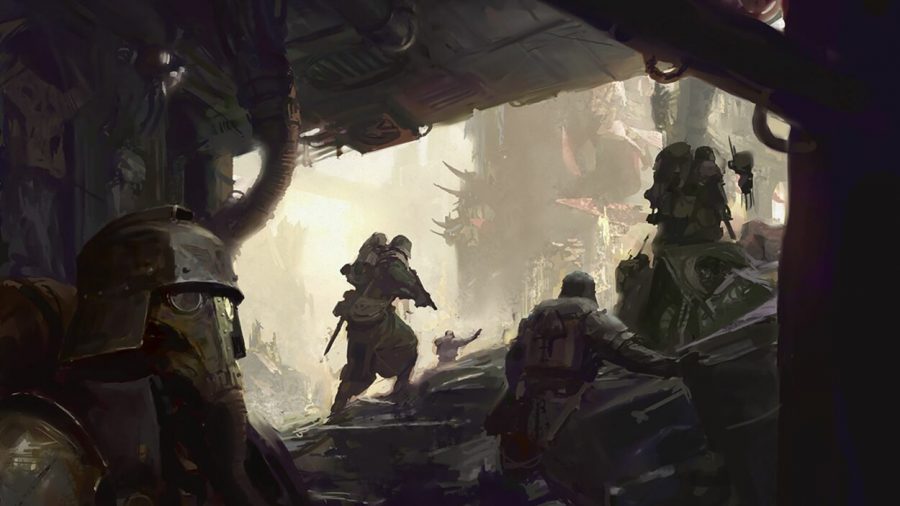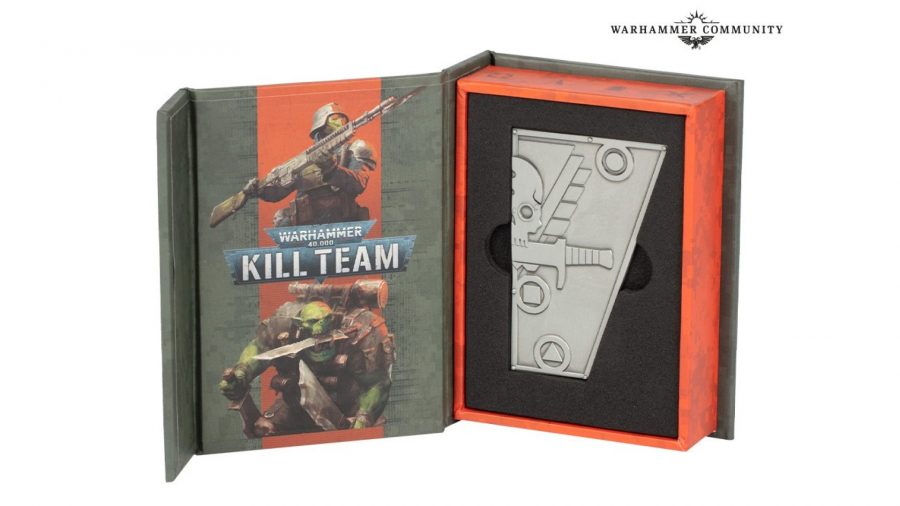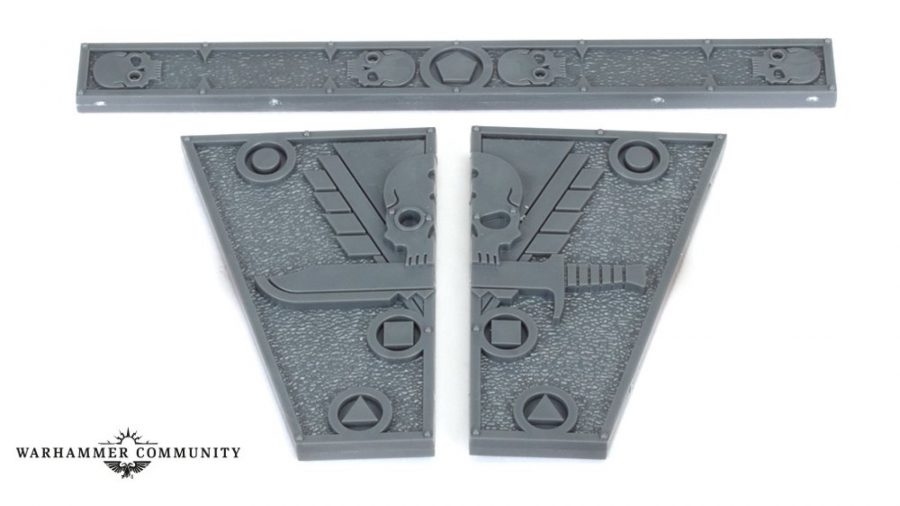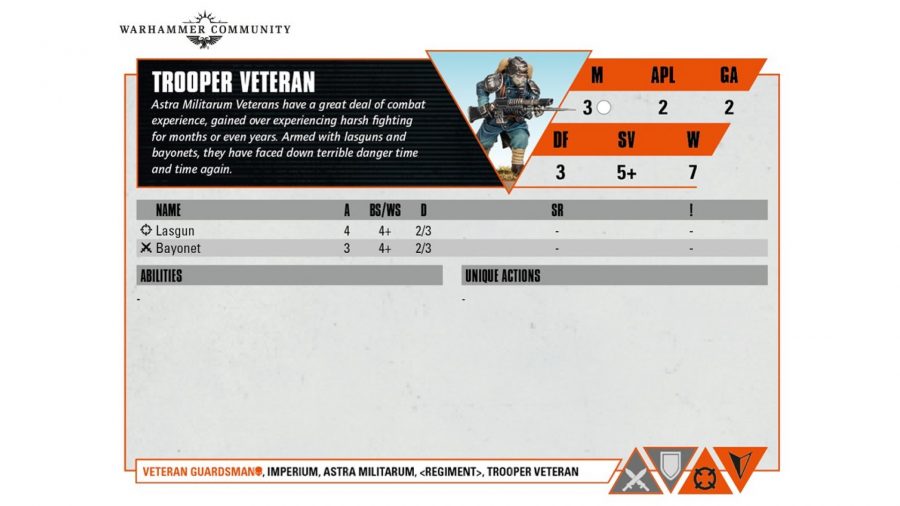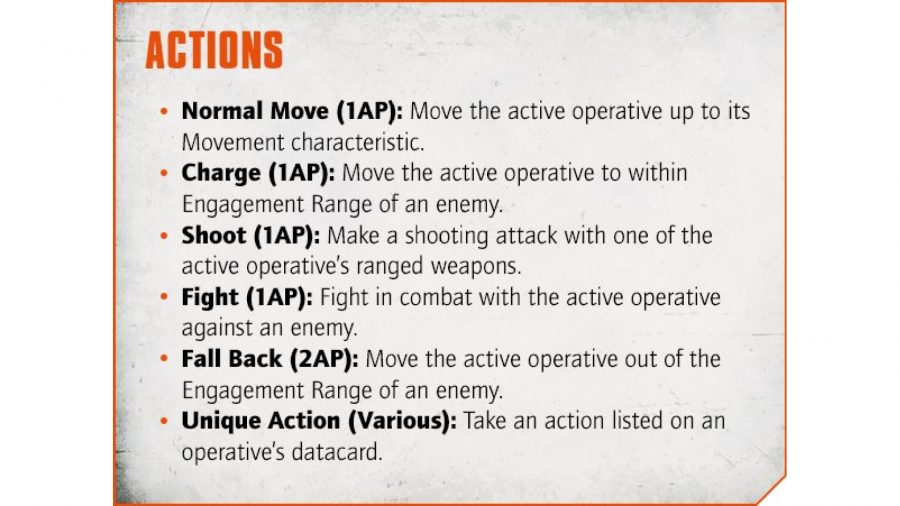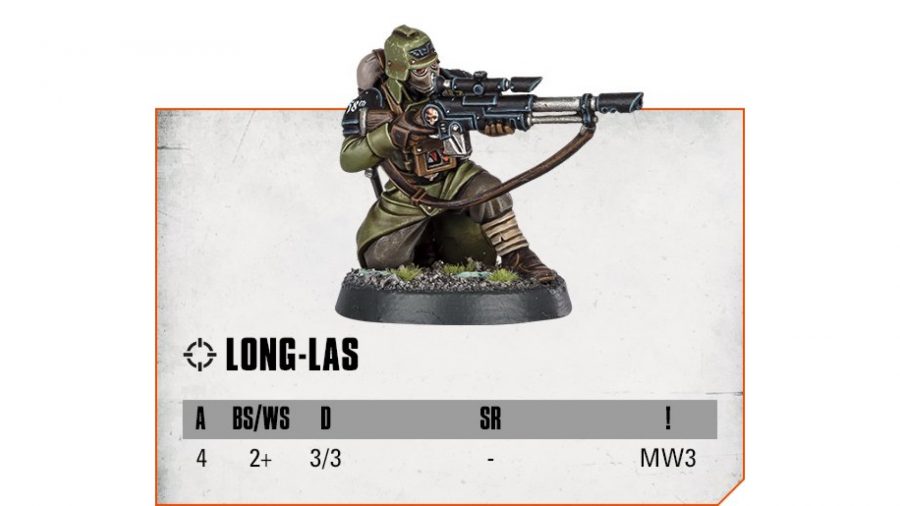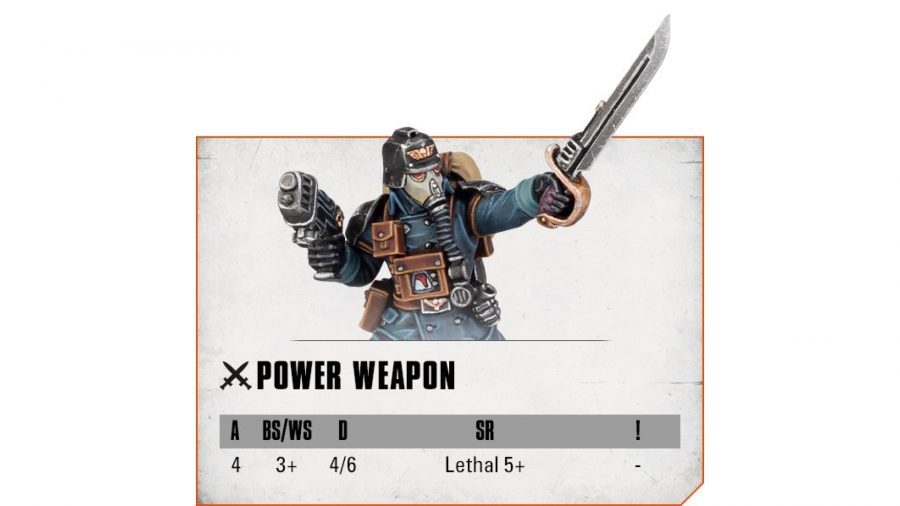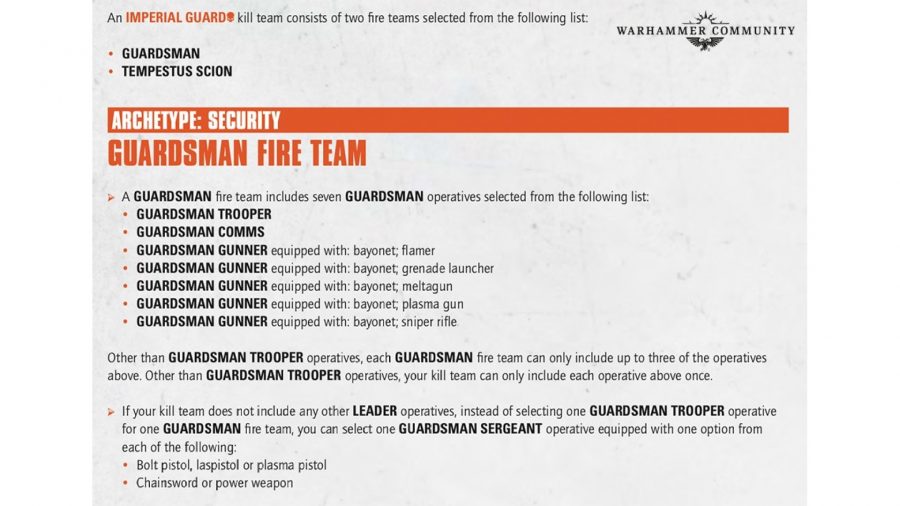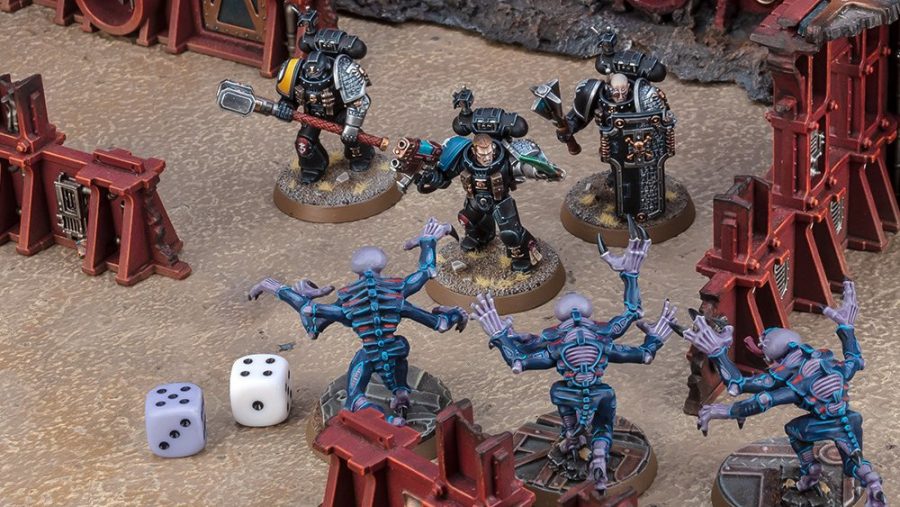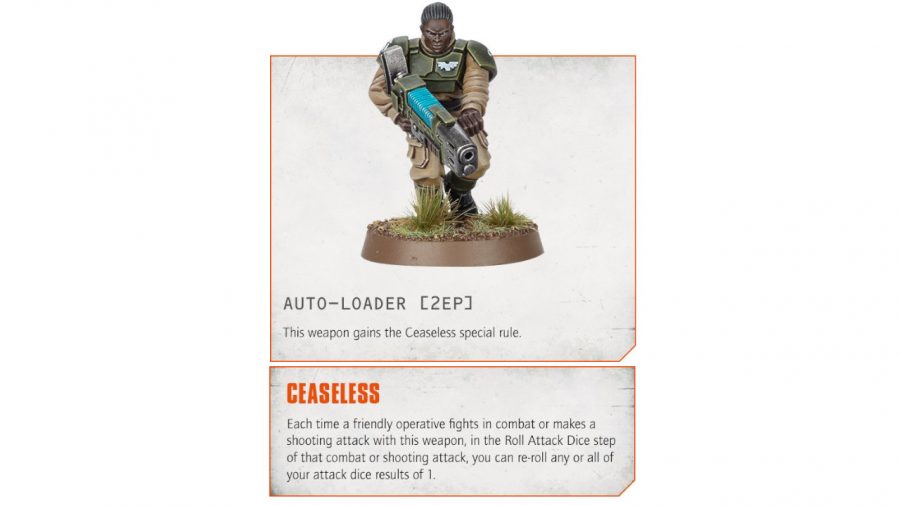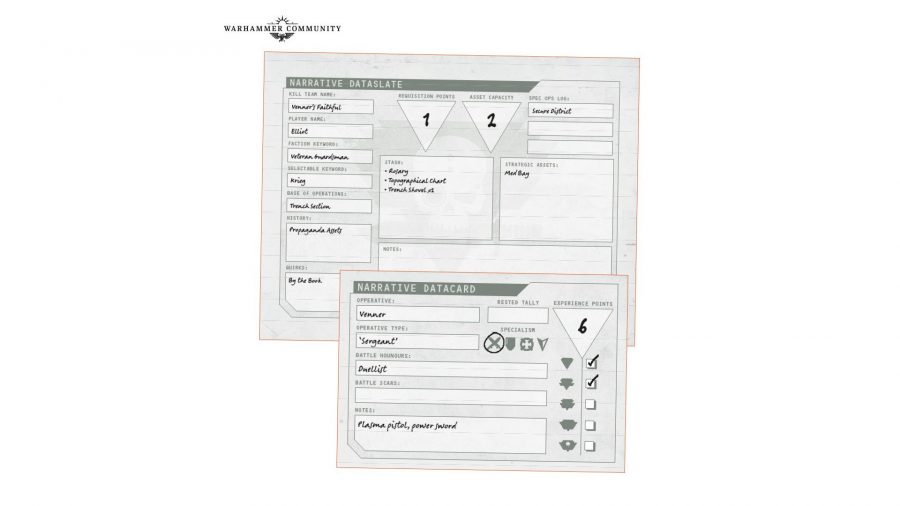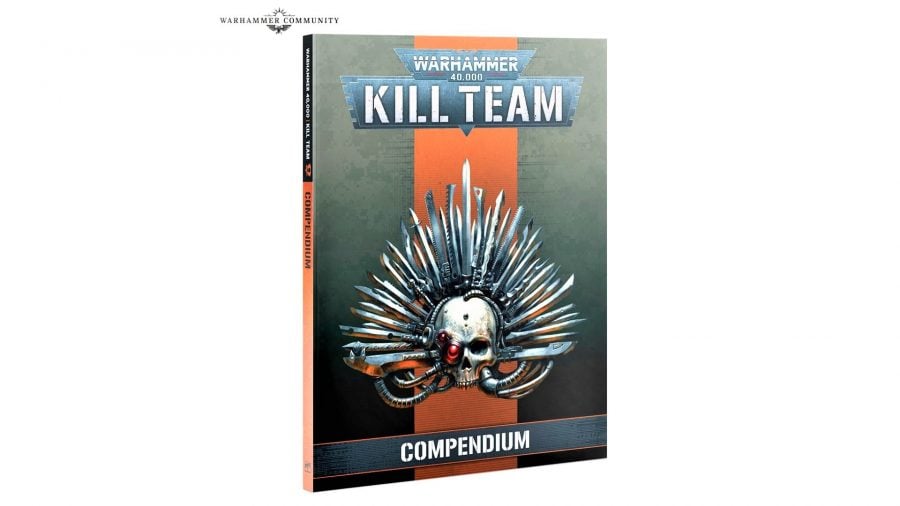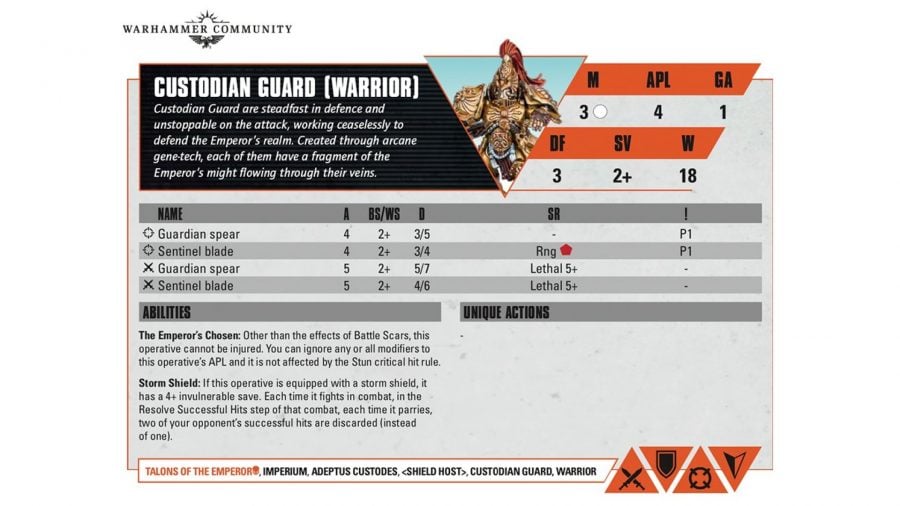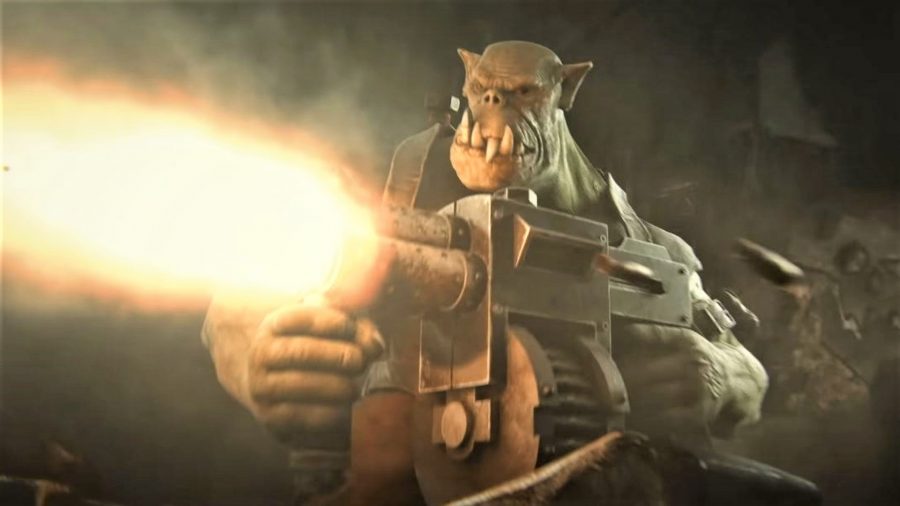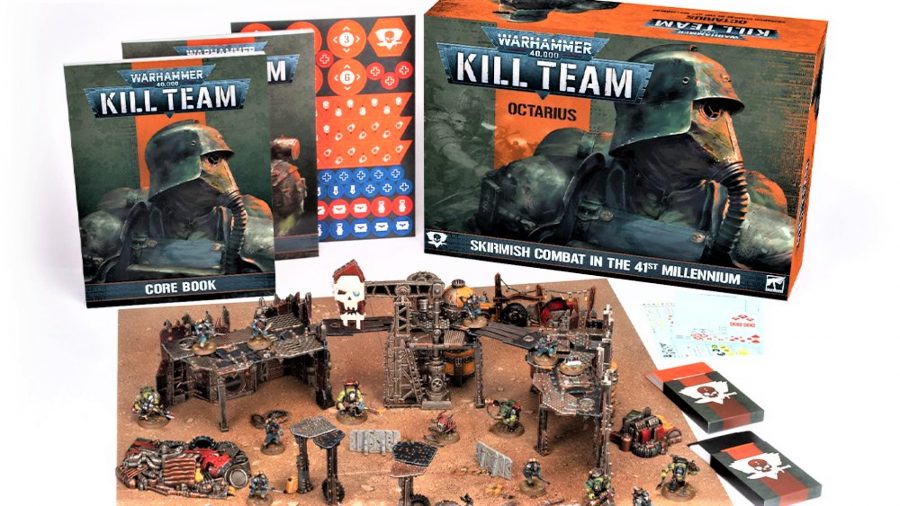Games Workshop is launching a second edition of Kill Team, the small-team skirmish variant of Warhammer 40k, with a lavish box set, titled Kill Team: Octarius. Since the initial announcement in a live-stream on Saturday, June 10 (and a savage CG trailer which you can watch below), GW has revealed a lot more information about the new game’s rules, materials, and specifics – so we’ve created this guide to pull together everything we know about the incoming Kill Team 2nd Edition.
For starters, the game’s second edition is starting with the rather chunky Octarius box set, which features Kill Teams for two popular 40k units never before released in plastic miniatures: the Astra Militarum’s gas-masked Death Korps of Krieg veterans, and the Orks’ sneaky, kunnin’ Kommandos. As with previous Kill Team sets, there’s also a stack of new terrain boxed in – this time, it’s Ork-themed, ramshackle metal fortifications and scrap piles.
In its earliest announcement, GW said the new edition had been “redesigned from the ground up with all-new rules”, and “represents a total reimagining of how combat on this scale should operate in the Warhammer 40,000 universe”. And, well, from all we’ve seen so far, that doesn’t sound too far off.
So, let’s get down to brass tacks:
Kill Team: Octarius release date AND PRE-ORDERS
Kill Team: Octarius went up for pre-order on August 14. However, in a change from the usual one-week Warhammer pre-order windows, the boxed set will be available to pre-order over two weeks, ending on August 28.
As of August 19, Kill Team Octarius was still available to pre-order from the GW Webstore. If you’re still on the fence as to whether to buy it, check out our comprehensive Kill Team Octarius review, covering the box, the game, and the Compendium supplement.
Unusually, GW had pledged in an August 9 Warhammer Community article that “everyone who pre-orders a copy of the new Kill Team this weekend [August 14-15] will get one”.
Acknowledging fans’ disappointment at the speed with which recent box sets have sold out online – most recently last weekend’s Hexfire Battlebox – GW says candidly in the article: “We know we’ve let you down in the past – so we’re going to do something about it, right now”.
The firm does, however, confirm that boxes will be shipped out first come, first served, and that, while it will send a box to everyone that orders over the weekend, “if you get in late, it might just take longer to get them to you… potentially several months longer – but you WILL get your copy”.
However, GW is not turning its back on the now infamous competitive rush to get its latest pre-order box before they’re all gone. It’s offering a limited edition “premium metal combat gauge” to the first few lucky orderers of Kill Team: Octarius.
We can expect the box to ship a week after pre-orders end; around early September. Games Workshop has taken pains to point out that Octarius is a launch box, so will only see a limited release. The first-weekend pre-order promise aside, when all copies are gone, that’s it.
Kill Team: Octarius box contents
Here’s what you get in the Kill Team: Octarius launch box:
- Death Korps of Krieg veteran guardsmen x 10
- Death Korps medkit (on its own base) x 1
- Ork Kommandos x 12
- New Kill Team rulebook x 1
- Mission book for the Octarius set x 1
- 30-by-22-inch gameboard x 1
- Large, orky terrain pieces x 5
- Smaller orky terrain pieces x 14
- Bag of matt orange d6 dice
- Sheet of cardboard tokens, including six objective markers
- Two sets of Tac Ops cards
- Two plastic movement gauges with one-inch, two-inch, and three-inch edges
- One six-inch measuring stick
Kill Team: Octarius Tutorial videos
To coincide with Kill Team: Octarius would go to pre-order on August 14, GW has released three walkthrough videos explaining exactly how games of Kill Team 2nd Edition are played- all three of which you can watch right here.
Dropped on August 9, the first tutorial video deals with:
- Some basic in-game terms, like ‘operator’ and ‘killzone’
- How to read operators’ datacards, and what the different stats mean

The second covers:
- Open, Narrative, and Matched play modes
- Game and turn structure
- Using order tokens to track which operators have activated so far
- The Initiative phase, and deciding who has Initiative
- The Strategy phase, command points, and using Strategic Ploys
- Tac Ops, and when they can be activated

And the third covers the real meat and potatoes of gameplay, the Firefight Phase, namely:
- How to activate operatives, and take actions
- Choosing Engage and Conceal orders for operators
- How to perform a Normal Move action
- How to perform a Shoot action
- How to roll and resolve saves when being shot at
- How damage, critical hits, and incapacitation work
- How to perform a Charge action
- How close combat works

Kill Team: Octarius rules
In a July 13 article, shortly after announcing the new edition, GW made the surprising announcement that, unlike its predecessors – which were effectively variants of, or add-ons to, Warhammer 40k – the new Kill Team 2nd Edition would completely eschew the 40k ruleset, and that its “every rule is bespoke”.
Here’s what you need to know about those new “bespoke” rules:
Kill Team Octarius – Movement
In a move which has provoked a really staggering number of memes and argument online, Kill Team 2nd Edition is adopting a system of plastic movement gauges with simple shape symbols on them, instead of tape-measures and numbers of inches.
In the new game, models’ movement stat is therefore given not in inches, but in regular increments of symbols referring to a specific side of the gauge. So, if your model’s Move stat is “2▲”, you can move it along two full lengths of the triangle-marked side of the gauge.
Since the actual lengths involved are still exact multiples of an inch (▲, for example, equals one inch) you can absolutely still use a tape-measure if you prefer, with the aid of very basic mental arithmetic – but GW reckons the new system makes games easier and quicker, especially when totting up move distances over obstacles and through terrain.
Only time, and games, will tell for sure!
Kill Team Octarius – Stats
Kill Team 2nd Edition’s datacards show that the new game’s units (individually called Operators) will have at least three key stats they didn’t have before:
- APL – Action Point Limit – controls how many ‘actions’ the unit can take each time it’s activated.
- DF – Defence – measures the unit’s ability to dodge incoming attacks; this is how many saving throws an operator can make each time they’re shot at.
- GA – Group Activation – As per a July 26 GW comment on the official 40k Facebook page, this refers to how many models are activated at a time. “Most operatives”, says GW, “are GA1, but some (a standard Guardsman trooper, a Gaunt, or a Poxwalker) have higher values and make it possible to use more than one operative in a turn”.
The list of stats for each operator is rounded out with some that will be more familiar to existing 40k or Kill Team players:
- M – Movement – controls how far an operator can move with a Normal Move action, as detailed above.
- SV – Save – tells you how high you need to roll on a d6 to pass a save roll. A roll of a six scores a Critical Save, which can cancel out a Critical Hit.
- W – Wounds – As ever, these should just be called hit points. This is the number of points of damage the operator can take before they are ‘incapacitated’.
All units are getting significantly more wounds than they had in the last edition – partly to keep them alive longer for more “cinematic moments”, and partly because weapon damage has had a buff, too.
Kill Team Octarius – Actions
Teased early on with the reveal of Kill Team 2nd Edition’s datacards and new APL stat, GW revealed on July 21 that the in-game ‘actions’ would indeed be used for everything your Kill Team operatives do in-game, as shown in the graphic above.
The key points we know so far on this are:
- The basic actions Normal Move, Charge, Shoot, Fight, and Fall Back are available to all operatives (though shooting, charging, and fighting are presumably subject to what weapon loadout the model has).
- Many operatives also have Unique Actions on their datacards, with their own listed AP cost and effects
- Once you activate an operative, actions can be taken in any order, unlike the strict phase order in the Warhammer 40k rules
- Most “baseline human and xenos” operators have an APL of two, meaning they can take two actions each time they activate – but Space Marines have three, and Adeptus Custodes have four.
- Some operators’ abilities can modify other operators’ APL stat, to buff allies or slow down enemies.
One unanswered question, currently, is whether an operator can take the same action more than once in an activation – to perform a double-move, or fight twice, for example.
Kill Team Octarius – Shooting
Shooting in Kill Team 2nd Edition has also had a bunch of tweaks which, combined, would seem to make the game much deadlier, taking cover much more important, and those increased wound counts much more appropriate.
Here’s a quick round-up:
- Guns now have unlimited range (unless marked otherwise)
- Hit rolls of 6 are critical hits, and do extra damage
- Rolls of 6 to save are critical saves; only critical saves can save critical hits
- Some guns have special rules on their datacard under “SR” – for example, the Krieg veterans’ flamers have a Torrent ability which splashes damage nearby targets – and their Long-Las sniper weapon deals 3 additional mortal wounds on a critical hit.
Kill Team Octarius – Melee
Close combat fighting in Kill Team 2nd Edition has seen perhaps the biggest rules change, introducing some interesting back-and-forth, gameplay into melee encounters.
As explained in a July 16 Warhammer Community article, models no longer get any armour saves against melee attacks.
Instead, in a system highly reminiscent of combat in Magic: The Gathering, models in melee combat roll their attacks against one another simultaneously – and then each rolled ‘hit’ can be spent to either deal damage, or block one of your opponent’s attacks.
More dangerous weapons, like the Power Sword above, also get Special Rules like Lethal (which increases chances of a crit), to further bump up their wielder’s odds of winning the battle of dice.
GW says it’s a system designed to “give true close combat specialists a real moment to shine”. We’ll be watching this portion very closely.
Kill Team Octarius – List building
As confirmed by GW on July 22, Kill Team 2nd Edition does not use explicit points costs for list building.
Instead, you’ll choose the members of your Kill Team from a pre-set menu of operator types, with different loadouts, depending on what faction you’re playing – with strict quotas limiting certain operator types for each faction, to keep games balanced.
Your Kill Team will also now be subdivided into one or more Fire Teams, depending on your faction – a mechanic intended to add structure, and differentiate between elite Kill Teams like Space Marines (who can only take one small Fire Team) and squishier factions like Imperial Guard, who (as you can see in the graphic above) can field two, with more operators in each.
Emperor’s will: Our Warhammer 40k Imperium factions guide
We don’t yet know if Fire Teams have any relevance in-game, or if they are merely for list-building purposes – but, given Kill Team 2.0’s apparent focus on force flexibility as a highly variable attribute between different factions, we wouldn’t be surprised to see multi-Fire Team factions able to deploy more widely, or in different ways, given their larger numbers.
Here’s what else we know so far about list building:
- The Death Korps of Krieg and Ork Kommandos Kill Teams included in the Octarius box are “complete game-ready forces” with various list-building options.
- In campaign play, you’ll have a roster of up to 20 operators, from which you’ll hand-pick a different Kill Team specially for each game, XCOM-style.
- A Death Guard Kill Team can take either three Plague Marines, or eight Poxwalkers.
Kill Team Octarius – Turn system
Far from the sprawling skirmishes of typical 40k, matches of Kill Team 2nd Edition will take place across a mere four turns, or Turning Points as Games Workshop is calling them. Each Turning Point is split into three distinct phases, which you and your plucky band of commandos must make the most if you’re to secure victory. These are:
- Initiative Phase
- Strategic Phase
- Firefight Phase
The Initiative Phase consists of a simple roll-off. Each player throws a d6 to determine who seizes the initiative and gets first pick at activating their units. Unlike previous editions of Kill Team, second edition has players take turns activating their units, swapping back and forth. While this might partially reduce the tactical importance of clinching the initiative, there are other boons to make up for it, such as the chance to decide when certain abilities are activated across the turn, or the order of specific effects.
The Strategic Phase, meanwhile, lets you spend any gathered Command Points on Strategic and Tactical Ploys. These faction-specific buffs grant temporary boosts to your units’ stats, such as the Death Korps of Kriegs’ ability to overcharge their lasguns for extra damage.
Finally, the Firefight Phase is exactly what it sounds like – a good old fashioned shootout. You and your opponent will take turns activating single operatives to move, shoot, and perform melee attacks. This is the real meat of the game that spans all the major actions covered above.
Kill Team Octarius – Equipment
Although Kill Team 2nd Edition might be doing away with points-based list building, it’s still offering opportunities for squad customisation. Before each showdown, you’ll be able to pick the equipment your operatives carry into battle, choosing extra pieces of gear from a faction-specific list.
Each item is assigned a point value, and you’ll have ten points to spend across your team. One-point items provide minor bonuses, such as the Markerlight that lets you reroll one of your attack dice against a marked target, while two-point options might prove as essential as your main weapon.
Warpin’ about: Read our Warhammer 40k Chaos factions guide
The Tyranids’ Feeder Tendrils, for instance, let the buggy aliens regain up to d3 wounds every time they incapacitate an enemy operative; and the Death Korps of Krieg’s infamous Trench Shovels grant light cover bonuses, as if the guardsmen were fighting in the trenches.
If you’re playing a narrative Spec Ops campaign (more on that below), equipment works a little differently. Rather than freely choosing any item that takes your fancy, your squad will earn rare pieces of equipment throughout their campaign, which look to be decidedly deadly.
The Auto-loader, for example, lets you reroll any number of attack dice – making landing your hits a breeze – while the Arc Unit upgrade reduces your target’s APL, as if stunning them into inaction.
Kill Team Octarius – Narrative campaigns
Kill Team 2nd Edition won’t be all about one-off scraps to the death. Its Spec Ops campaign mode lets you field your operatives across persistent narrative battles, earning new skills and equipment along the way.
Using a ‘narrative dataslate’ and accompanying ‘datacards’ you’ll be able to keep track of your operatives’ heroic, or possibly suicidal, deeds, and record the various items they collect for their stash between Spec Ops. Complete the objectives of these multi-staged missions, and you’ll earn big rewards, as well commendations to mark on your sheets.
The costs could be high, though. Should an operative lose all their wounds during a mission, they’ll have to make a Casualty Test at the match’s end to determine what, if any, persistent damage they sustain. Push them too far without letting them rest between missions, and that bullet wound to their skull might be a little more permanent than you had anticipated.
The idea is to add a level of persistence across the game, alongside more narrative flavour. Games Workshop has said you won’t have to opt-in or out, though, with Spec Ops players able to progress through their campaigns even when battling one-off, matched play opponents.
Kill Team Compendium
As announced by GW in its July 23 edition of ‘Kill Team: Octarius titbits’, the list-building rules, quotas, and datacards for every Warhammer 40k faction (except Imperial Knights and Chaos Knights) will be included in a separate book, titled Kill Team: Compendium – rather than rolled into the main rulebook, as was the case in the previous edition.
GW says the Kill Team: Compendium supplement will be available “at the same time as the launch box” – which means some time in August 2021. No exact pre-order or release dates have been announced.
We don’t yet know how much the Kill Team: Compendium supplement will cost at launch, how long it is, or what else it contains, other than the basic “rosters and datacards, including stats for all the available operatives”.
Though the decision to split the faction rules into a separate book has led to some consternation among fans online, it was a somewhat predictable development, given the sheer amount of additional page space required for the new edition’s list-building menu tables, as compared to old-style points.
For comparison, the previous edition of Kill Team’s rulebook ran to 208 pages, fully 111 of which were devoted to faction rules, datacards, points costs, and other flavour content for each army. Rules content, by contrast, filled a mere 54 pages: 28 pages of core rules; 11 pages of missions; and 15 pages covering Specialists.
Alien swarms: Our Warhammer 40k Xenos factions guide
Given Kill Team 2nd Edition starts again with a bespoke, more involved ruleset, and new campaign options to boot, we can expect the main rules section to need at least as many pages, probably more. Add in the chunky new list-building tables, plus any faction flavour content, and it’s clear that a unified rulebook and faction compendium would have been an incredibly hefty tome to lug about.
However, the move has been criticised by some as hostile to new players, as it arguably creates another barrier to entry by effectively requiring players buy the rulebook and Compendium to get started – instead of a single combined volume.
For some existing players, too, it’s seen as part of a wider trend towards proliferation of required rulebooks, and the overall Games Workshop hobby becoming more expensive.
Kill Team: Octarius trailers
The most recent Kill Team: Octarius trailer is the reveal trailer shown as part of the Warhammer Preview Online stream on July 10 – exploding the box’s contents and showcasing both the Astra Militarum Death Korps of Krieg models, and the Ork Kommandos, in amongst the included terrain.

Even that trailer, replete with titillating footage of the first ever plastic Death Korps veterans and Ork Kommandos, couldn’t match the cinematic glories of the hype-up CG trailer that dropped on the previous evening, however.
Check this out; it’s easily one of the best fully animated trailers GW has ever produced.

With the advent of Warhammer+, and GW’s growing roster of in-house and licenced animated video projects, it seems we’ll be getting more of these high-production-value trailers to celebrate big box product launches. And we at Wargamer are A-OK with that.
Kill Team 2nd Edition BACKGROUND
There had been some speculation among the Warhammer 40k and Kill Team communities as to whether 40k’s small-team spinoff was, in fact, being slowly retired – given a somewhat poor reception to its most recent release, Pariah Nexus, in March 2021.
The latter was largely due to fan frustration at a much-anticipated, popular 40k unit (the Space Marines’ Heavy Intercessors) being, initially, only available through the Pariah Nexus box. Instead, GW has given Kill Team the honour of fanfaring in War Zone Octarius, the “next major narrative supplement for Warhammer 40,000”.
Kill Team, as a skirmish-based variant for Warhammer 40k, has now gone through a total of four iterations over the years – the third of which was when Games Workshop released it as an official, standalone game , complete with a distinct ruleset, bright orange branding, and starter sets composed of existing models and terrain.
It’s since had several expansions, from rules supplements like 2018’s Commanders, to boxed sets containing exclusive models, most recently Kill Team: Pariah Nexus.
This new release, however, looks to represent Kill Team’s furthest step away from the core Warhammer 40k rules. How popular this independent new edition proves, and therefore how much new content it may merit in the coming years, remains unknown.
